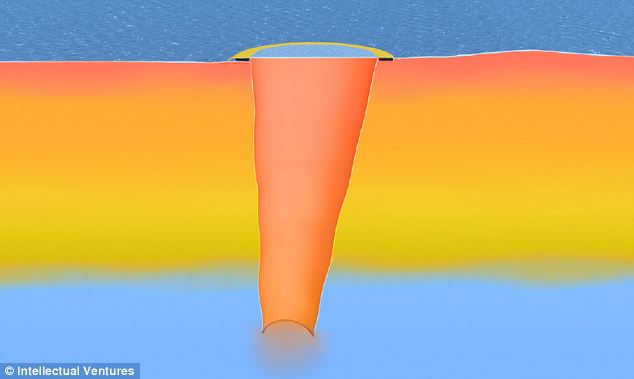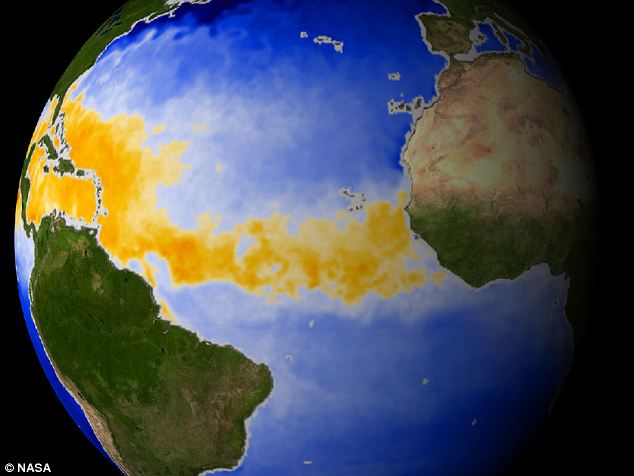- Staff
- #1
- 25,905
- 10,784
The British scientist who claims Sandy could have been avoided with car tires
Professor Stephen Salter's invention would cool the ocean's surface to stop deadly hurricanes from forming
Structures built from used car tires would form wave-powered pumps that would mix the warm surface waters with cooler waters below
The devastation wrought by hurricane Sandy could have been avoided by a simple but ingenious technology made from old car tires, Britain's leading marine engineer claims.
Thousands of car tires lashed together to support tubes extending deep into the ocean could avert hurricanes, says Stephen Salter, emeritus professor of engineering design at Edinburgh University.
With the backing of Microsoft billionaires Bill Gates and Nathan Myhrvold's company Intellectual Ventures, he has patented the idea but says further funding is urgently needed to research the scheme.

The Inlet section of Atlantic City, New Jersey, as Hurricane Sandy struck the U.S. last week: The huge storm wrought devastation across the Caribbean and the east coast of the U.S.
Hurricanes are areas of intense low pressure that form over warm ocean waters. The source of their energy is water vapor which evaporates from the ocean surfaces, fueling the storm with the latent heat of condensation.
The so-called 'Salter Sink' harnesses wave power to in effect stir up the ocean, bringing cooler water from below stopping the surface from reaching the kinds of temperatures that cause the most devastating hurricanes.
It works as a wave-powered pump, with the ocean swell pushing hot water into the top of the cylinder, with gravity then pushing that water down as far as 200m where it mixes with the cool deep.
Over time, this action mixes the ocean waters bringing surface temperatures down and lessening the potential for a devastating hurricane to form.

How it works: A ring 80-100 meters across floats on an assembly of discarded tires, lashed together and filled with a buoyant substance, such as foamed concrete

Harnessing wave power: The surface of the ring rises a meter or so above the sea level. Ocean swells passing over the structure fill it with warm surface water

Mixing up the oceans: A tube connected to the inside of the ring sinks 50-300 meters to the cooler water below. Gradually the tube fills with warm water, which drains out the bottom. It has a tapered profile to accelerate the velocity of the flow and to improve mixing of the warm exhaust water with the colder water at depth
Intellectual Ventures suggests sinks ranging from 10m to 100m in diameter could potentially remove heat from the surface of the ocean at gigwatt rates.
Professor Salter told the Observer that harnessing energy from waves to cool the ocean to makes ecological sense. The pumps would be placed in 'hurricane alley', the region of the Atlantic around the equator where the worst storms form.
The sinks would have to be put in place months before the beginning of the hurricane season in late spring, and retrieved just before the major storms arrive - but by then their job should be done.
'It may take thousands of these to protect America’s Gulf region (for example) but we estimate the cost would be much lower than the damage caused by one of these storms,' Intellectual Ventures says on its website.
Professor Salter added that he estimates 150-450 of the structures would be needed to suppress the formation of deadly hurricanes. 'They would drift around and send out radar signals so that no one would collide with them,' he told the Observer.

'Hurricane alley' is a strip within the Atlantic Ocean where sea surface temperatures reach 28 °C (82 °F) or higher in late spring and summer (shown in orange for May 2003). The region that fuels tropical storms and hurricanes shifts annually but always stretches from east Africa to the Caribbean and the Gulf of Mexico
Professor Salter first came up with the idea after seeing the damage and suffering caused in New Orleans by Hurricane Katrina and first presented it to the U.S. government in 2007.
The U.S is prioritizing research into hurricane suppression, with seven of the 10 deadliest hurricanes to hit that country having struck since 2004.
At the latest estimates, Hurricane Sandy has caused a total of $30billion (£19billion), with the economic costs of hurricanes in the U.S. and Caribbean since 2002 clocking in at a phenomenal $200billion (£125billion).
Professor Salter claims the mechanics of his technology has been proven, but says research funding is urgently needed to investigate the ecological effects it might have.
Although he has written to the UK government's chief scientific officer, British officials have previously shied away from funding research into his marine technologies.
In 1982 he invented the idea of a mechanical device that could bob up and down on the ocean generating electricity, but the government subsequently shut the UK Wave Energy programme claiming it was too expensive.
It later emerged that civil servants from the energy department's nuclear power division had 'miscalculated' by a factor of 10 the cost of energy production from Professor Salter's device.
It has been claimed that decision may have set back British wave energy research by 20 years.
Now watch a video about how the Salter Sink would work:
http://www.dailymail.co.uk/sciencet...scientist-claims-Sandy-avoided-car-tyres.html
Professor Stephen Salter's invention would cool the ocean's surface to stop deadly hurricanes from forming
Structures built from used car tires would form wave-powered pumps that would mix the warm surface waters with cooler waters below
The devastation wrought by hurricane Sandy could have been avoided by a simple but ingenious technology made from old car tires, Britain's leading marine engineer claims.
Thousands of car tires lashed together to support tubes extending deep into the ocean could avert hurricanes, says Stephen Salter, emeritus professor of engineering design at Edinburgh University.
With the backing of Microsoft billionaires Bill Gates and Nathan Myhrvold's company Intellectual Ventures, he has patented the idea but says further funding is urgently needed to research the scheme.

The Inlet section of Atlantic City, New Jersey, as Hurricane Sandy struck the U.S. last week: The huge storm wrought devastation across the Caribbean and the east coast of the U.S.
Hurricanes are areas of intense low pressure that form over warm ocean waters. The source of their energy is water vapor which evaporates from the ocean surfaces, fueling the storm with the latent heat of condensation.
The so-called 'Salter Sink' harnesses wave power to in effect stir up the ocean, bringing cooler water from below stopping the surface from reaching the kinds of temperatures that cause the most devastating hurricanes.
It works as a wave-powered pump, with the ocean swell pushing hot water into the top of the cylinder, with gravity then pushing that water down as far as 200m where it mixes with the cool deep.
Over time, this action mixes the ocean waters bringing surface temperatures down and lessening the potential for a devastating hurricane to form.

How it works: A ring 80-100 meters across floats on an assembly of discarded tires, lashed together and filled with a buoyant substance, such as foamed concrete

Harnessing wave power: The surface of the ring rises a meter or so above the sea level. Ocean swells passing over the structure fill it with warm surface water

Mixing up the oceans: A tube connected to the inside of the ring sinks 50-300 meters to the cooler water below. Gradually the tube fills with warm water, which drains out the bottom. It has a tapered profile to accelerate the velocity of the flow and to improve mixing of the warm exhaust water with the colder water at depth
Intellectual Ventures suggests sinks ranging from 10m to 100m in diameter could potentially remove heat from the surface of the ocean at gigwatt rates.
Professor Salter told the Observer that harnessing energy from waves to cool the ocean to makes ecological sense. The pumps would be placed in 'hurricane alley', the region of the Atlantic around the equator where the worst storms form.
The sinks would have to be put in place months before the beginning of the hurricane season in late spring, and retrieved just before the major storms arrive - but by then their job should be done.
'It may take thousands of these to protect America’s Gulf region (for example) but we estimate the cost would be much lower than the damage caused by one of these storms,' Intellectual Ventures says on its website.
Professor Salter added that he estimates 150-450 of the structures would be needed to suppress the formation of deadly hurricanes. 'They would drift around and send out radar signals so that no one would collide with them,' he told the Observer.

'Hurricane alley' is a strip within the Atlantic Ocean where sea surface temperatures reach 28 °C (82 °F) or higher in late spring and summer (shown in orange for May 2003). The region that fuels tropical storms and hurricanes shifts annually but always stretches from east Africa to the Caribbean and the Gulf of Mexico
Professor Salter first came up with the idea after seeing the damage and suffering caused in New Orleans by Hurricane Katrina and first presented it to the U.S. government in 2007.
The U.S is prioritizing research into hurricane suppression, with seven of the 10 deadliest hurricanes to hit that country having struck since 2004.
At the latest estimates, Hurricane Sandy has caused a total of $30billion (£19billion), with the economic costs of hurricanes in the U.S. and Caribbean since 2002 clocking in at a phenomenal $200billion (£125billion).
Professor Salter claims the mechanics of his technology has been proven, but says research funding is urgently needed to investigate the ecological effects it might have.
Although he has written to the UK government's chief scientific officer, British officials have previously shied away from funding research into his marine technologies.
In 1982 he invented the idea of a mechanical device that could bob up and down on the ocean generating electricity, but the government subsequently shut the UK Wave Energy programme claiming it was too expensive.
It later emerged that civil servants from the energy department's nuclear power division had 'miscalculated' by a factor of 10 the cost of energy production from Professor Salter's device.
It has been claimed that decision may have set back British wave energy research by 20 years.
Now watch a video about how the Salter Sink would work:
http://www.dailymail.co.uk/sciencet...scientist-claims-Sandy-avoided-car-tyres.html

